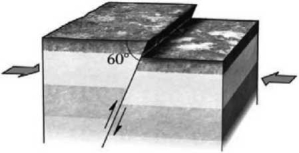During an earthquake, if the hanging wall slides upward relative to the footwall and if the fault is steep (closer to vertical than horizontal) , then the fault is termed a ___________ fault. Refer to the following figure for an example of such a feature. 
A) normal
B) reverse
C) strike-slip
D) thrust
Correct Answer:
Verified
Q2: Body waves include
A) both S- and P-waves.
B)
Q2: If a fault is nearly vertical in
Q3: A surface along which rock on opposed
Q4: At any point along the surface of
Q5: At a minimum, how many seismic stations
Q10: The vast majority of earthquakes occur
A)associated with
Q11: Earthquakes often occur along
A)bedding planes.
B)terminal moraines.
C)faults.
D)river valleys.
Q12: Periods of intermittent sliding on a fault
Q20: A primary force opposing motion on all
Q29: Vertical motion seismographs record earthquakes by producing
Unlock this Answer For Free Now!
View this answer and more for free by performing one of the following actions

Scan the QR code to install the App and get 2 free unlocks

Unlock quizzes for free by uploading documents